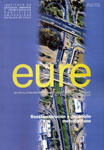High speed railway and metropolitan integration in Spain: the case of Ciudad Real and Puertollano
DOI:
https://doi.org/10.4067/S0250-71612005009200005Keywords:
urban infrastructure, territorial integration, mobility, urban transportationAbstract
Ciudad Real and Puertollano, two small Spanish cities approximately one hours travelling time from Madrid on the Madrid-Sevilla High Speed Train (HST) line, are of particular interest in the study of the impact of HSTs on such centres of population. Both cities had been separated from the main transportation corridor between Madrid and Andalusia since the end of the 18th Century and, at the end of 1992, the HST line reintegrated them into this corridor. That same year the Autopista de Andalucía (Andalusia Freeway), whose route runs some 50 kilometres to the east of Ciudad Real and Puertollano, entered into service. The current article has three basic objectives. The first one is to determine the most appropriate type of methodology to analyse the effect produced by an HST ten years after its inception. The second is to describe the observed changes in the mobility patterns of the inhabitants of Ciudad Real and Puertollano. The article concentrates on the employment profile and the frequency of use of those who habitually travel on the HST to and from Madrid. Thirdly, the article analyses the role the HST has played firstly in integrating the two cities with each other, and secondly in integrating both with the metropolitan area of Madrid. It then analyses the distinct effects of each of the two transport routes (freeway and HST) on each of the two cities, paying attention to their economic peculiarities (Ciudad Real being a tertiary city and Puertollano being an industrial one).
ÍDownloads
Published
How to Cite
Issue
Section
License
Copyright (c) 2005 Revista EURE - Revista de Estudios Urbano Regionales

This work is licensed under a Creative Commons Attribution 4.0 International License.
Al momento de aceptar la publicación de sus artículos, los autores deberán formalizar la cesión de derechos de autor a EURE, según las condiciones establecidas por la Revista.
Ésta establece que el autor autoriza a EURE de manera gratuita, exclusiva e ilimitada a reproducir, editar, publicar, distribuir, publicitar, comercializar y traducir el artículo, a cualquier soporte conocido o por conocer y desarrollar.
Del mismo modo, los autores aseguran que el artículo propuesto es original, no publicado y no propuesto para tal fin a otro medio de difusión.


